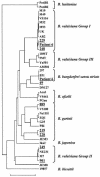PCR-reverse line blot typing method underscores the genomic heterogeneity of Borrelia valaisiana species and suggests its potential involvement in Lyme disease
- PMID: 12904377
- PMCID: PMC179804
- DOI: 10.1128/JCM.41.8.3690-3698.2003
PCR-reverse line blot typing method underscores the genomic heterogeneity of Borrelia valaisiana species and suggests its potential involvement in Lyme disease
Abstract
Detection of the Borrelia burgdorferi sensu lato complex in biological samples is currently done by conventional immunological and molecular biological methods. To improve on the accuracy of these methods and to simplify the procedure for testing large numbers of samples, a solid-phase sandwich hybridization system readily applicable to the detection of PCR products has been designed. This colorimetric detection system relies on the use of polybiotinylated detection probes and of specific capture oligonucleotides covalently linked at allocated positions on nylon membrane strips. From a phylogenetic analysis on a great number of ospA gene sequences, we have designed and synthesized a set of PCR primers specific to the five Borrelia burgdorferi sensu lato genospecies present in Europe and a subset of probes (capture and detection probes) specific to these five genospecies (B. burgdorferi sensu stricto, B. garinii, B. afzelii, B. valaisiana, and B. lusitaniae). This combined PCR hybridization system was evaluated with a large number of various B. burgdorferi isolates and clinical specimens. These analyses clearly showed that the system could be used as a typing method to distinguish five genospecies belonging to the B. burgdorferi sensu lato complex. In addition, the study showed that B. valaisiana strains might be more heterologous than suspected up to now and clustered into three genomic groups.
Figures


Similar articles
-
Polymerase chain reaction in diagnosis of Borrelia burgdorferi infections and studies on taxonomic classification.APMIS Suppl. 2002;(105):1-40. APMIS Suppl. 2002. PMID: 11985118
-
Three species of Borrelia burgdorferi sensu lato (B. burgdorferi sensu stricto, B afzelii, and B. garinii) identified from cerebrospinal fluid isolates by pulsed-field gel electrophoresis and PCR.J Clin Microbiol. 1996 May;34(5):1072-8. doi: 10.1128/jcm.34.5.1072-1078.1996. J Clin Microbiol. 1996. PMID: 8727878 Free PMC article.
-
Evaluation of a genotyping method based on the ospA gene to detect Borrelia burgdorferi sensu lato in multiple samples of lyme borreliosis patients.New Microbiol. 2007 Oct;30(4):399-410. New Microbiol. 2007. PMID: 18080675
-
Molecular typing of Borrelia burgdorferi sensu lato: taxonomic, epidemiological, and clinical implications.Clin Microbiol Rev. 1999 Oct;12(4):633-53. doi: 10.1128/CMR.12.4.633. Clin Microbiol Rev. 1999. PMID: 10515907 Free PMC article. Review.
-
Updates on Borrelia burgdorferi sensu lato complex with respect to public health.Ticks Tick Borne Dis. 2011 Sep;2(3):123-8. doi: 10.1016/j.ttbdis.2011.04.002. Epub 2011 May 27. Ticks Tick Borne Dis. 2011. PMID: 21890064 Free PMC article. Review.
Cited by
-
Diagnosis of lyme borreliosis.Clin Microbiol Rev. 2005 Jul;18(3):484-509. doi: 10.1128/CMR.18.3.484-509.2005. Clin Microbiol Rev. 2005. PMID: 16020686 Free PMC article. Review.
-
Typing African relapsing fever spirochetes.Emerg Infect Dis. 2005 Nov;11(11):1722-9. doi: 10.3201/eid1111.050483. Emerg Infect Dis. 2005. PMID: 16318724 Free PMC article.
-
Phenotypic and genotypic analysis of Borrelia spp. isolated from Ixodes ricinus ticks by using electrophoretic chips and real-time polymerase chain reaction.Folia Microbiol (Praha). 2007;52(4):315-24. doi: 10.1007/BF02932085. Folia Microbiol (Praha). 2007. PMID: 18062179
-
Carbodiimide-mediated cross-linking of RNA to nylon membranes improves the detection of siRNA, miRNA and piRNA by northern blot.Nucleic Acids Res. 2007;35(8):e60. doi: 10.1093/nar/gkm112. Epub 2007 Apr 2. Nucleic Acids Res. 2007. PMID: 17405769 Free PMC article.
-
Characterization of Borrelia lusitaniae isolates collected in Tunisia and Morocco.J Clin Microbiol. 2005 Apr;43(4):1587-93. doi: 10.1128/JCM.43.4.1587-1593.2005. J Clin Microbiol. 2005. PMID: 15814970 Free PMC article.
References
-
- Balmelli, T., and J. C. Piffaretti. 1995. Association between different clinical manifestations of Lyme disease and different species of Borrelia burgdorferi sensu lato. Res. Microbiol. 146:329-340. - PubMed
-
- Baranton, G., G. Seinost, G. Theodore, D. Postic, and D. Dykhuizen. 2001. Distinct levels of genetic diversity of Borrelia burgdorferi are associated with different aspects of pathogenicity. Res. Microbiol. 152:149-156. - PubMed
-
- Beaucage, S. L., and M. H. Caruthers. 1981. Deoxynucleoside phosphoramidites, a new class of key intermediates for deoxypolynucleotide synthesis. Tetrahedron Lett. 22:1859-1862.
Publication types
MeSH terms
Substances
LinkOut - more resources
Full Text Sources
Medical

